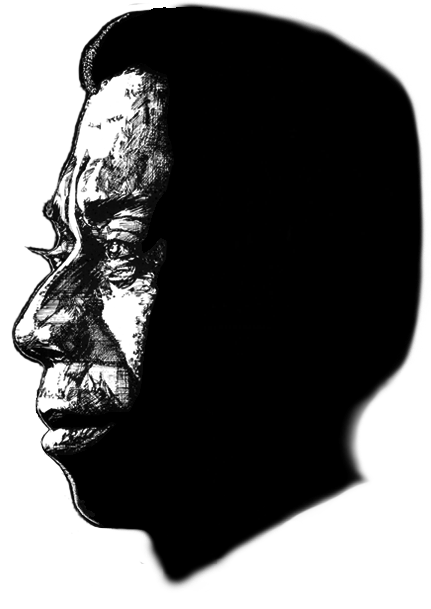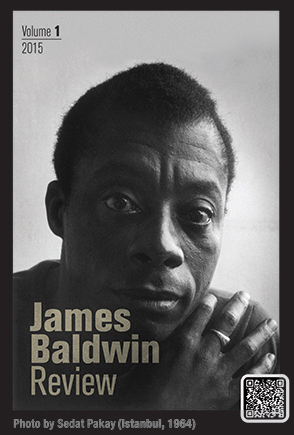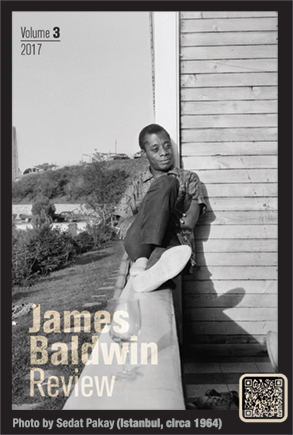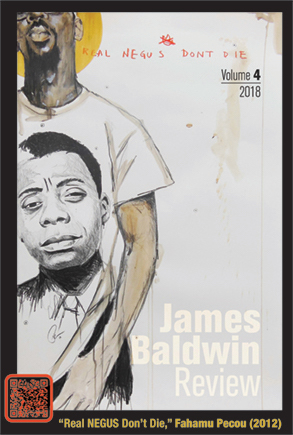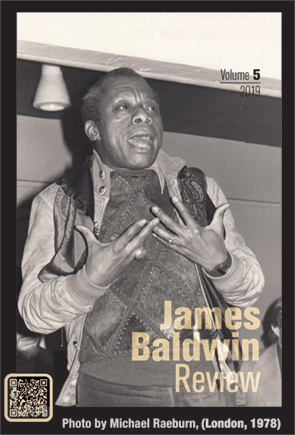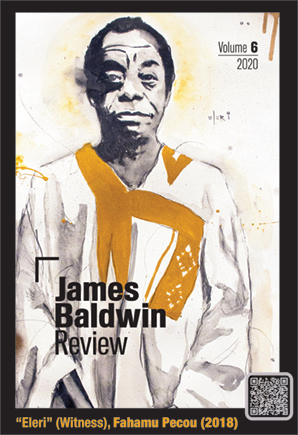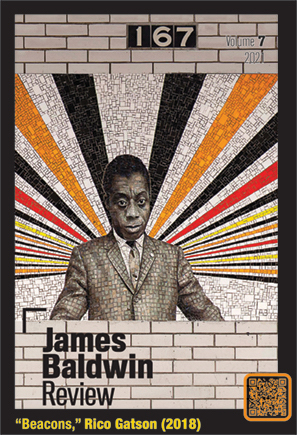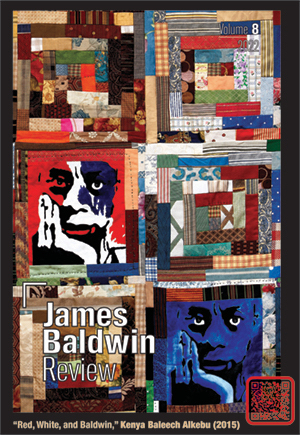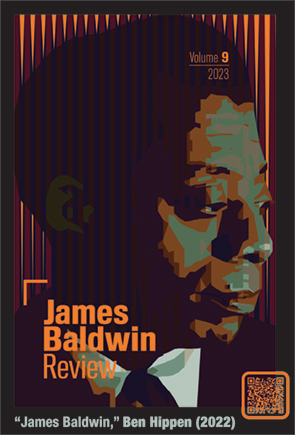A prestigious peer-reviewed annual journal, the James Baldwin Review was created in 2014 to deepen understanding of world-famous author/activist James Baldwin (1924-1987). Published in the U.S., the U.K., and online, the Review explores Baldwin’s life, writings and legacy via an international selection of cutting-edge essays, creative non-fiction, and cover art.
Over the past decade, Review covers have included public artworks, archival photographs, quilts, tee-shirts, acrylic art, and oil paintings from artists all over the world.
As we see in the JBR covers featured below, Baldwin’s image speaks volumes:
eyes that bear witness to the complexities, terrors, and promise of American history; hands that hint at the boy who left his Harlem pulpit, then became a secular preacher; a smile that offers hope and encouragement for our collective future.- TO VIEW A PARTICULAR VOLUME's "Table of Contents" on the James Baldwin Review website, use the blue "JBR Volume #" link, found below each Cover Art image. (Note: Volume 1 & Volume 2 use the same cover photograph.)
- Photograph by Sedat Pakay
www.SedatPakay.com - This 1964 portrait of Baldwin is one of many captured by young Turkish photographer Sedat Pakay. A 19-year-old graduate of Istanbul’s Robert College—where David Leeming, Baldwin’s friend and eventual biographer, was his teacher—Pakay first met Baldwin in 1964. For Baldwin, Turkey was a refuge, a place where he could write without the pressures of fame. For Pakay, Baldwin was a compelling subject: face, heart, and mind. Over the course of a decade, they intersected multiple times, in both Istanbul and the U.S. And in 1970—after Pakay completed studies with two legendary artists, photographer Walker Evans and filmmaker Albert Maysles, at the Yale School of Art—he returned to Turkey to direct his first film, a cinéma vérité portrait of Baldwin. Titled From Another Place, this 12-minute short was completed in 1973.
-
- Photograph by Sedat Pakay
www.SedatPakay.com - This 1965 photo of Baldwin, one of many captured by photographer Sedat Pakay, was taken at Kilyos Beach on Turkey’s Black Sea Coast. For Baldwin, Turkey was a refuge, a place where he could write without the pressures of fame. For Pakay, Baldwin was a compelling subject: face, heart, and mind. Over the course of a decade, they intersected multiple times, in both Istanbul and the U.S. And in 1970—after Pakay completed studies with two legendary artists, photographer Walker Evans and filmmaker Albert Maysles, at the Yale School of Art—he returned to Turkey to direct his first film, a cinéma vérité portrait of Baldwin. Titled From Another Place, this 12-minute short was completed in 1973.
-
- Courtesy of a Private Collection, Paris, France
Painting by Dr. Fahamu Pecou
www.FahamuPecouArt.com - This 2012 Baldwin homage by Atlanta-based artist/scholar Dr. Fahamu Pecou is part of his series "Real Negus Don’t Die": famous faces on t-shirts worn by Black male bodies, drawn with graphite and acrylic on Arches paper. Pecou began drawing in childhood, a series of comic strips centered around his own superhero, "Black Man." After graduating from Atlanta College of Art in 1997, he started out as a graphic designer, with clients ranging from politicians to nightclubs. Then the music took hold: while collaborating with rap artists and music labels, he began to apply their strategies to his own art. His early paintings juxtaposed fine art with in-your-face hip hop bravado and street savvy.
Now, along with his own academic writings, he combines acrylic-on-canvas with video, music, and performance art to explore the complexities of black masculinity and identity. -
- Courtesy of writer/filmmaker Michael Raeburn
[photographer unknown]
www.MichaelRaeburn.com - This 1978 photograph documents Baldwin’s delivery of his own ‘Black Fire’ as he addresses an audience in London’s Africa Centre. The event was a book launch for Michael Raeburn’s Black Fire!, a collection of narratives about South African liberation with an introduction by Baldwin. [Published in the U.K. by Julian Friedman, the book was later re-issued in the U.S. as We Are Everywhere.] Raeburn’s friendship with Baldwin began back in 1974, when they met at the London book launch for If Beale Street Could Talk. A student of French literature and film, the Egyptian-born, Zimbabwe-raised Raeburn connected with Baldwin on multiple levels. In 1977, they began collaborating on a screenplay for Giovanni’s Room: unfinished because funding never materialized, it remains a project that Raeburn—now an internationally recognized filmmaker in his own right—hopes to complete.
-
- Painting by Dr. Fahamu Pecou
www.FahamuPecouArt.com - This 2018 acrylic-on-canvas portrait by Atlanta-based artist/scholar Dr. Fahamu Pecou pays tribute to Baldwin as witness and prophet. Raised in South Carolina, Pecou began drawing in childhood, a series of comic strips centered around his own superhero, "Black Man." After graduating from the Atlanta College of Art in 1997, he started out as a graphic designer, with clients ranging from politicians to nightclubs. Then the music took hold: while collaborating with rap artists and music labels, he began to apply their strategies to his own art. His early paintings juxtaposed fine art with in-your-face hip hop bravado and street savvy. Now, along with his own academic writings, he combines acrylic-on-canvas with video, music and performance art to explore the complexities of black masculinity and identity.
-
- Mural Installation by Rico Gatson
@rico_gatson - This 2018 glass mosaic of a radiant Baldwin was created by Georgia-born, California-raised, Brooklyn-based multimedia artist Rico Gatson. Based on a 1963 photograph by Steve Schapiro, it is now a permanent installation in NYC’s 167th Street subway station: one of eight Gatson murals celebrating cultural and political ‘beacons of hope.’ Drawn from his earlier museum exhibit, Icons, these subway portraits include Maya Angelou, James Baldwin, Celia Cruz, Reggie Jackson, Audre Lorde, Tito Puente, Gil Scott-Heron, and Justice Sonia Sotomayor—all of whom, according to Gatson, "impacted my world view." A Yale School of Art graduate known for geometric compositions and bold innovations, his oeuvre includes painting, sculpture, and video that highlights Black life and its impact on popular culture.
-
- Quilt Art by Kenya Baleech Alkebu
Angola Prison, Louisiana State Penitentiary
Contact M. Kelleher, thxkatrina@gmail.com - This 2015 quilt features acrylic-on-cotton portraits of Baldwin by Kenya Baleech Alkebu. At age 22, Kenya was sentenced by a non-unanimous jury to life in prison; he has been locked inside Louisiana’s notorious Angola Prison for over 44 years, working in the law library and mentoring fellow inmates. As a volunteer for the prison’s hospice program, he began quilting in 2006 to raise funds for end-of-life care. For him, "Quilting is optimism." Built on the grounds of a former cotton plantation, Angola Prison is "a very lonely place. Sometimes it feels like I’m being squeezed tightly by history—but designing cotton squares on land worked by slaves is my way of holding the hand of freedom and hope."
Why does he turn to Baldwin? "It’s an honor to celebrate this man’s legacy: he muffled the drumbeat of those who thought ex-slaves inferior; he gives me, a neo-slave, reason to live out loud, to come out from the shadows." The Kenya/Baldwin connection is deep. Much of Baldwin’s work, both fiction and non-fiction, explores incarceration: how rigid categories such as Black & White, gay & straight, right & wrong imprison individuals in both physical and metaphorical cages. As Baldwin wrote in No Name in the Street (1972), "I do not claim that everyone in prison is innocent, but I do claim that the law, as it operates, is guilty." -
- Digital Illustration by Ben Hippen
@benhippen - This 2022 digital portrait was created by Ben Hippen, an Iowa-based composer/ songwriter and visual artist whose usual medium is acrylic-on-hardboard. This image was the fortunate result of a COVID quarantine; he began experimenting with a graphics tablet, developing a series of portraits, and Baldwin was his inspired choice. Hippen describes how his passion for the world-famous author began: "I vividly remember my first encounter with Baldwin. Thirty-five years ago, I was reading Another Country over a plate of steak & eggs at 2AM in a nearly empty joint off Boston's Kenmore Square. The honesty and power of his language impressed me deeply and the relevance of his themes has not faded since."
-
JAMES BALDWIN REVIEW
A Peer-Reviewed Annual Journal

Publisher ~ University of Manchester Press
Editors ~ Douglas Field, University of Manchester
~ Justin A. Joyce, Washington University in St. Louis
~ Dwight McBride, Washington University in St. Louis
"Portrait of the Author" (1964)
"Black Sea Portrait of Jimmy" (1965)
"Real Negus Don’t Die: The Fire Inside" (2012)
"James Baldwin at Black Fire Book Launch" (1978
"Eleri" [Yoruba word for "Witness"] (2018)
"Beacons" (2018)
"Red, White, and Baldwin" (2015)
"James Baldwin" (2022)
. . . . . . .
